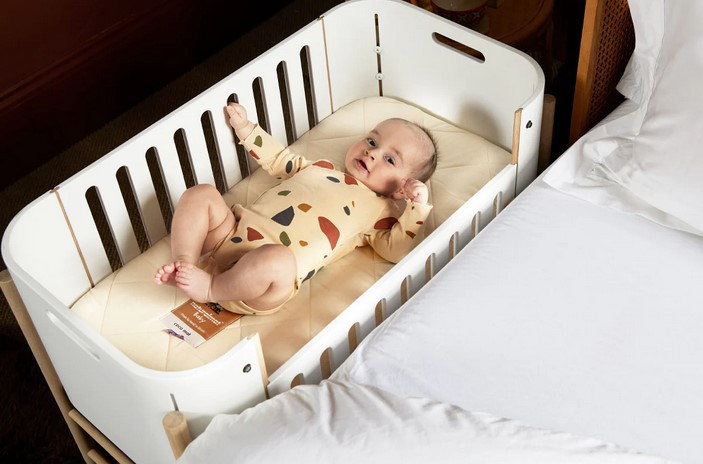The Different Types of Crib Springs: Which One is Right for Your Baby?
Crib springs serve as the foundation for a comfortable and secure sleep space for infants. These ingenious mechanisms provide essential support to the crib mattress, ensuring proper ventilation and a safe sleeping environment for babies. With their sturdy construction and thoughtful design, crib springs offer peace of mind to parents, knowing that their little ones are resting soundly and comfortably.

When it comes to selecting a crib for your baby, safety and comfort are paramount considerations. Among the many components that contribute to these factors, the type of crib spring plays a crucial role. Crib springs provide the support and flexibility necessary for a comfortable sleeping environment for your little one. However, with a variety of options available, it’s essential to understand the different types of crib springs and how to choose the one that suits your baby’s needs.
1. Standard Coil Springs:
Standard coil springs are perhaps the most traditional type of crib springs. They consist of interconnected metal coils that provide firm support for the mattress. These springs offer durability and stability, ensuring that your baby’s mattress maintains a consistent level of support. While standard coil springs can provide an adequate level of comfort for most babies, they may not be the best option for those with specific sleep needs.
2. Pocketed Coil Springs:
Pocketed coil springs are an innovation in crib spring technology. These springs are individually wrapped in fabric pockets, allowing them to respond more independently to pressure. This characteristic makes pocketed coil springs excellent for distributing the baby’s weight evenly across the mattress surface. The enhanced responsiveness of these springs can contribute to a more comfortable sleep for your baby, as the mattress adjusts to their movements.
3. Dual Firmness Springs:
Dual firmness springs are designed to provide two levels of support within the same mattress. This type of crib spring is particularly useful for infants and toddlers. One side of the mattress offers a firmer surface for newborns, while the other side provides a slightly softer surface for when your baby becomes a toddler. This adaptability ensures that the mattress can cater to your child’s changing needs as they grow, potentially saving you from having to buy a new mattress as your baby gets older.
4. Continuous Coil Springs:
Continuous coil springs, also known as Bonnell coils, consist of a single piece of wire formed into multiple coils. These coils are interconnected, providing consistent support across the entire mattress. While continuous coil springs are sturdy and durable, they may not offer the same level of individualized support as pocketed coil springs. They are commonly found in more affordable crib mattresses and can provide satisfactory comfort for many babies.
5. Memory Foam and Innerspring Hybrids:
In recent years, crib mattresses that combine memory foam and innerspring technology have gained popularity. These hybrids aim to offer the benefits of both types of materials. Memory foam provides contouring support, while innerspring coils offer responsiveness and durability. While these hybrids can be pricier, they can be an excellent investment if you’re looking for a balance between comfort and support.
Choosing the Right Crib Spring for Your Baby:
Selecting the right type of crib spring involves considering your baby’s age, sleep habits, and any specific health concerns. Here are a few factors to keep in mind:
1. Age and Developmental Stage:
Newborns require firmer support to ensure proper spinal alignment and reduce the risk of Sudden Infant Death Syndrome (SIDS). As your baby grows into a toddler, a slightly softer surface may be more comfortable for their developing body. Dual firmness mattresses are a convenient choice in this regard.
2. Sleep Preferences:
Some babies are more sensitive to their sleep environment than others. If your baby seems restless on a standard crib mattress, you might consider pocketed coil springs for better pressure distribution and motion isolation.
3. Allergies and Sensitivities:
If your baby has allergies or sensitivities, you might want to opt for a mattress with hypoallergenic materials. Look for crib springs and mattresses with covers that are easy to remove and wash.
4. Longevity and Budget:
Consider how long you expect your baby to use the crib mattress. While investing in a high-quality mattress can provide long-term comfort and support, it’s essential to balance your budget with your baby’s needs.
5. Safety Standards:
Whichever type of crib spring you choose, ensure that the crib mattress meets safety standards set by organizations like the Consumer Product Safety Commission (CPSC). This includes proper fitting within the crib, as well as flame-retardant and non-toxic materials.
In conclusion, the type of crib spring you select can significantly impact your baby’s comfort and sleep quality. Standard coil springs, pocketed coil springs, dual firmness springs, continuous coil springs, and memory foam and innerspring hybrids each offer unique benefits. By considering your baby’s age, sleep preferences, health concerns, budget, and safety standards, you can make an informed decision that provides your little one with a supportive and comfortable sleep environment. Remember, choosing the right crib spring is an investment in your baby’s well-being and early development.
